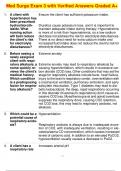Med Surge Exam 3 with Verified Answers Graded A+
1. A client with Ensure the client has sufficient potassium intake.
hypertension has
been prescribed
hydrochloroth- Diuretics cause potassium loss, and it is important to
iazide. What maintain adequate intake during therapy. Hyponatremia
nursing action is more of a risk than hypernatremia, so a low-sodium
will best reduce diet does not address the risk for electrolyte disturbances.
the client's risk There is no direct need for extra calcium intake and
for electrolyte increased fluid intake does not reduce the client's risk for
disturbances? electrolyte disturbances.
2. Before seeing a Extreme anxiety
newly assigned
client with respi-
ratory alkalosis, a Extreme anxiety may lead to respiratory alkalosis by
nurse quickly re- causing hyperventilation, which results in excessive car-
views the client's bon dioxide (CO2) loss. Other conditions that may set the
medical history. stage for respiratory alkalosis include fever, heart failure,
Which condition injury to the brain's respiratory center, overventilation with
is a predisposing a mechanical ventilator, pulmonary embolism, and early
factor for respira- salicylate intoxication. Type 1 diabetes may lead to dia-
tory alkalosis? betic ketoacidosis; the deep, rapid respirations occurring
in this disorder (Kussmaul's respirations) don't cause ex-
cessive CO2 loss. Myasthenia gravis and opioid overdose
suppress the respiratory drive, causing CO2 retention,
not CO2 loss; this may lead to respiratory acidosis, not
alkalosis.
3. Which could be a Hypoventilation
potential cause of
respiratory acido-
sis? Respiratory acidosis is always due to inadequate excre-
tion of CO2, with inadequate ventilation, resulting in ele-
vated plasma CO concentration, which causes increased
levels of carbonic acid. In addition to an elevated PaCO2,
hypoventilation usually causes a decrease in PaO2.
4. A client has a Increases arterial pH
respiratory rate
, Med Surge Exam 3 with Verified Answers Graded A+
of 38 breaths/min.
What effect does Respiratory alkalosis is always caused by hyperventila-
breathing faster tion, which is a decrease in plasma carbonic acid con-
have on arterial centration. The pH is elevated above normal as a result
pH level? of a low PaCO2.
5. A client pre- Potassium 3.0 mEq/L (mmol/L)
sents with fatigue,
nausea, vomit-
ing, muscle weak- Potassium is the major intracellular electrolyte. Hy-
ness, and leg pokalemia (below 3.5 mEq/L) usually indicates a deficit
cramps. The labo- in total potassium stores. Potassium deficiency can re-
ratory values are sult in derangements in physiology. Clinical signs include
as follows fatigue, anorexia, nausea, vomiting, muscles weakness,
sodium is 147 leg cramps, decreased bowel motility, and paresthesias.
mEq/L (mmol/L) The sodium, chloride and magnesium levels are within
potassium is 3.0 normal limits.
mEq/L (mmol/L)
chloride is 112
mEq/L (mmol/L)
Magnesium is
2.3 mg/dL
(0.95mmol/L)
What laborato-
ry value is
consistent with
the client's symp-
toms?
6. A nurse is caring Provide oral care every 2-3 hours.
for a client with
acute renal failure
and hypernatrem- Providing oral care for the client every 2-3 hours is within
ia. In this case, the scope of practice of a nursing assistant. The other
which action can actions should be completed by the registered nurse.
be delegated to
the nursing assis-
tant?
, 7. A nurse is assess- Jugular vein distention
ing a client with
syndrome of in-
appropriate antid- Jugular vein distention requires further action because
iuretic hormone. this finding signals vascular fluid overload. Tetanic con-
Which finding re- tractions aren't associated with this disorder, but weight
quires further ac- gain and fluid retention from oliguria are. Polyuria is as-
tion? sociated with diabetes insipidus, which occurs with inad-
equate production of antidiuretic hormone.
8. A client with Pulse
chronic renal fail-
ure has a serum
potassium level of An elevated serum potassium level may lead to a
6.8 mEq/L. What life-threatening cardiac arrhythmia, which the nurse can
should the nurse detect immediately by palpating the pulse. In addition to
assess first? assessing the client's pulse, the nurse should place the
client on a cardiac monitor because an arrythmia can
occur suddenly. The client's blood pressure may change,
but only as a result of the arrhythmia. Therefore, the nurse
should assess blood pressure later. The nurse also may
delay assessing respirations and temperature because
these aren't affected by the serum potassium level.
9. A client reports hypokalemia
muscle cramps in
the calves and
feeling "tired a Hypokalemia causes fatigue, weakness, anorexia, nau-
lot." The client is sea, vomiting, cardiac dysrhythmias, leg cramps, muscle
taking ethacryn- weakness, and paresthesias. Many diuretics, such as
ic acid (Ede- ethacrynic acid (Edecrin), also waste potassium. Symp-
crin) for hypoten- toms of hyperkalemia include diarrhea, nausea, mus-
sion. Based on cle weakness, paresthesias, and cardiac dysrhythmias.
these symptoms, Signs of hypocalcemia include tingling in the extremities
the client will and the area around the mouth and muscle and ab-
be evaluated for dominal cramps. Hypercalcemia causes deep bone pain,
which electrolyte constipation, anorexia, nausea, vomiting, polyuria, thirst,
imbalance? pathologic fractures, and mental changes.




